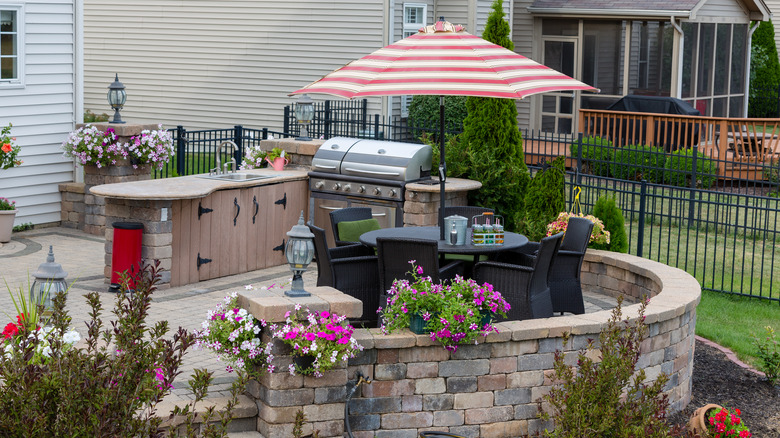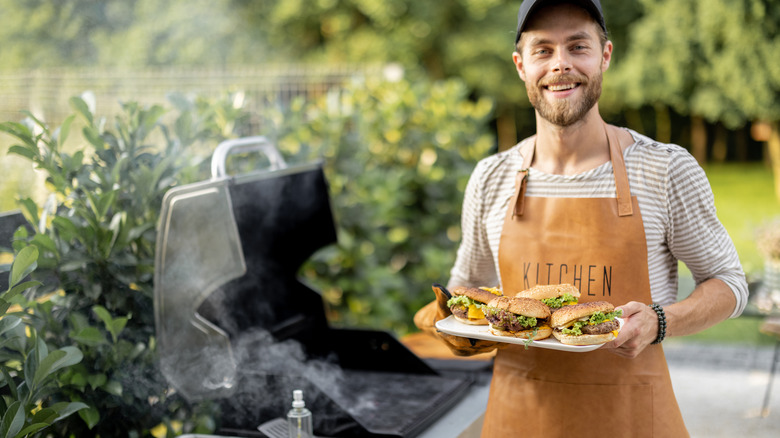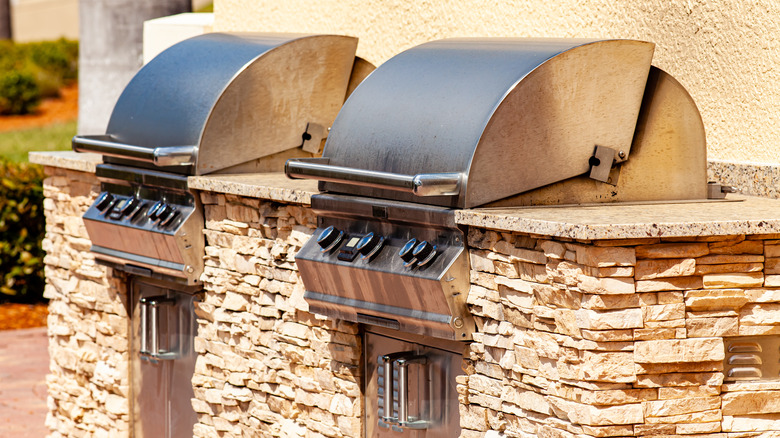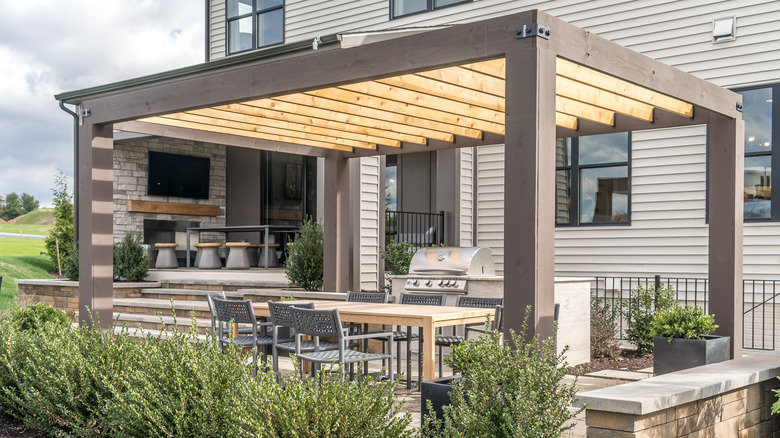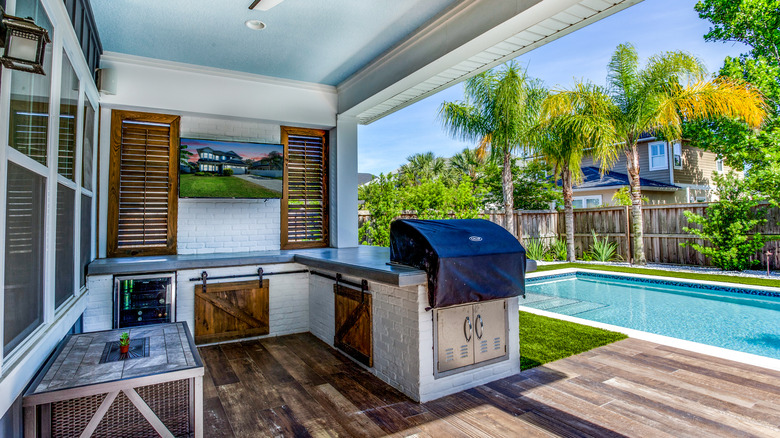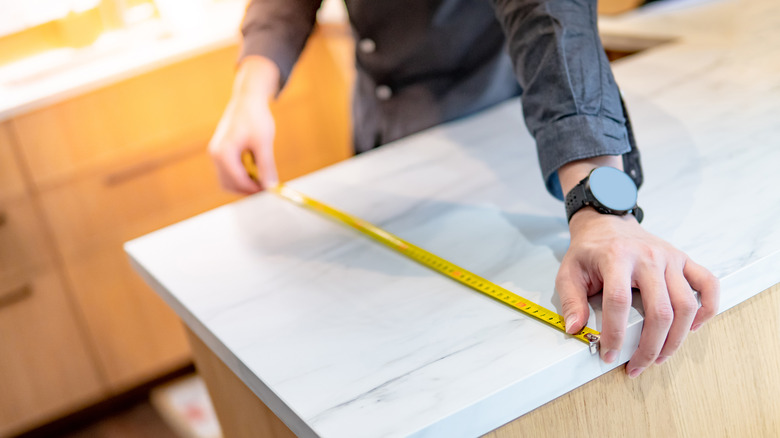5 Pointers To Know Before Building An Outdoor Kitchen
When you have a lot of outdoor space, there are various things you can use it for. For instance, you can transform it into a garden or a gathering area with a fire pit, and there's even the luxury option of installing a hot tub! If you love hosting and entertaining, though, you must have considered an outdoor kitchen multiple times. Outdoor kitchens provide more than enough space for people to gather and share the joys of preparing food together. The nice, open area out in nature also spurs inspiration and motivation to cook. Two other reasons include saving on utility bills by keeping indoor heat levels low and keeping cooking smells out of the house (via CompactAppliance).
It is a significant investment and commitment to add an outdoor kitchen to your house, but Brown Jordan Outdoor Kitchens says it's worth it because it adds to the value of a home. It can even bring in a 100% to 200% ROI! However, there are five things to get sorted out before you set out to build an outdoor kitchen.
1. Know why you want the new kitchen
This is probably the most important thing you need to get clear on first. Ask yourself why you want an outdoor kitchen because the answers will serve as your guide throughout the process. For example, do you need the extra space because you cook a lot and in large quantities? Do you host often and want a nice space dedicated to entertaining? When you settle on your why, you will know how much you'll spend, what kinds of appliances you'll need, and what the space will look like.
Think about your current cooking and hosting situation. What are the best parts about it, and what is lacking? Then you can see how an outdoor kitchen can address those needs and improve on the good parts. Yours can be a simple, elevated barbecue area or fully fitted like an indoor kitchen. Maybe it will include a bar. During your brainstorming process, you might even realize that you're more interested in an indoor-outdoor kitchen, as One Kindesign points out.
2. Know your budget
Your budget will depend on what you're going for and what you need to achieve that. First, identify the level the scale of your project; the budget will fall under the modest, mid-range, or top-of-the-line style, as pointed out by RTA Outdoor Living. For example, an average outdoor kitchen will cost around $12,000 and $13,000, but if you want to fully outfit the space, you could be looking at a range of $5,500 to $34,000 for the counters, cabinets, and appliances (via Homes & Gardens).
You also need to figure out how much preparation the area needs before you can put the kitchen system in place. Will you need landscaping? Power or water connections? Then you'll have to factor in the costs of that as well as the labor, says Homes & Gardens. As with anything else, it's important to first determine your must-haves. If that pizza oven has to be a part of your kitchen, find out what style you want, how to maintain it, and the tools needed to operate it. An outdoor bar might require special seats, bartender kits, and maybe even a TV to serve as a focal point.
3. Determine your design plan carefully
There are so many directions you can take with your kitchen design! From beachy colors to a cottage style, you can choose the theme you want based on your priorities for the space. If it's all about your family and friends, lots of seating and storage space will be key. If you're more into aesthetics, then you're looking for a solid theme with sleek, matching countertops and cabinets.
A House Digest survey revealed quartz countertops to be the most popular kitchen design feature, loved for their elegant appearance. When it comes to cabinets, gray and white are classic color schemes, but you can shake things up with an unconventional color like baby blue or something bright like yellow.
The design also needs to be functional — the best island is multifunctional and adaptable to your needs. The grill size should also be in line with the average number of people you expect to host, and there should be adequate ventilation around it, advises CompactAppliance. Finally, make sure you have proper lighting as well as flooring that can withstand weather and use.
4. Have a checklist of the items you need
When you've determined the magnitude of your project and how much you're willing and able to spend, you need to know exactly what appliances you need. According to BBQGuys, it's best to have a checklist of everything your new space might require, from ice machines to cooling and heating systems. You might also realize that there are some things in your indoor kitchen that you can just bring outside when needed.
You should also know how to maintain what you buy. For example, new furniture will most likely be a major purchase, so if you can't install a full covering for the space, learn how to weatherproof the different types of chairs and tables that will be out there.
For example, wood needs to be properly sealed so it doesn't absorb water and rot, while wicker and plastic must be kept clean at all times. You can also apply a waterproof spray to cushions and other items covered with fabric to prevent mold. Finally, metal should be treated for rust so it doesn't spread. If you maintain your things, they will last longer and look exceptional even after years of use.
5. Choose whether to DIY or hire a contractor
Love taking on complex DIY projects? An outdoor kitchen is a great one to handle. This is definitely the cheaper route and can be a nice experience to share when you do it with friends and family. According to This Old House, a DIY outdoor kitchen can cost around $800 for the structure and should take two weekends for moderately-skilled DIYers to assemble. If you don't want to build it from scratch, you can install an RTF (ready-to-finish) option, which is an already-built frame, or get an RTA (ready-to-assemble) kitchen, which requires even less work, says RTA Outdoor Living.
On the other hand, a contractor might be more appealing because you don't want to make any mistakes, and you want it to be done expertly. While there are many contractors out there to do this job, it's important to be careful with your decision. Take your time to research and ensure that the person or team you choose is the right fit. Oasis Outdoor Living advises hiring a contractor with a minimum of 25 outdoor kitchens to their name, checking their reviews, and even walking through some of their finished projects if possible.
